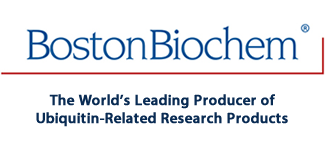
Recombinant Human Ubiquitin N-Terminal Rhodamine Protein, CF Summary
Product Datasheets
Carrier Free
CF stands for Carrier Free (CF). We typically add Bovine Serum Albumin (BSA) as a carrier protein to our recombinant proteins.Adding a carrier protein enhances protein stability, increases shelf-life, and allows the recombinant protein to be stored at a more dilute concentration.The carrier free version does not contain BSA.
In general, we advise purchasing the recombinant protein with BSA for use in cell or tissue culture, or as an ELISA standard.In contrast, the carrier free protein is recommended for applications, in which the presence of BSA could interfere.
U-600
| Formulation | Lyophilized from a solution in HEPES and NaCl. |
| Reconstitution | Reconstitute at 10 mg/mL in an aqueous solution. |
| Shipping | The product is shipped with polar packs. Upon receipt, store it immediately at the temperature recommended below. |
| Stability & Storage: | Protect from light. Use a manual defrost freezer and avoid repeated freeze-thaw cycles.
|
Reconstitution Calculator
Background: Ubiquitin
Ubiquitin is a 76 amino acid (aa) protein that is ubiquitously expressed in all eukaryotic organisms. Ubiquitin is highly conserved with 96% aa sequence identity shared between human and yeast Ubiquitin, and 100% aa sequence identity shared between human and mouse Ubiquitin (1). In mammals, four Ubiquitin genes encode for two Ubiquitin-ribosomal fusion proteins and two poly-Ubiquitin proteins. Cleavage of the Ubiquitin precursors by deubiquitinating enzymes gives rise to identical Ubiquitin monomers each with a predicted molecular weight of 8.6 kDa. Conjugation of Ubiquitin to target proteins involves the formation of an isopeptide bond between the C-terminal glycine residue of Ubiquitin and a lysine residue in the target protein. This process of conjugation, referred to as ubiquitination or ubiquitylation, is a multi-step process that requires three enzymes: a Ubiquitin-activating (E1) enzyme, a Ubiquitin-conjugating (E2) enzyme, and a Ubiquitin ligase (E3). Ubiquitination is classically recognized as a mechanism to target proteins for degradation and as a result, Ubiquitin was originally named ATP-dependent Proteolysis Factor 1 (APF-1) (2,3). In addition to protein degradation, ubiquitination has been shown to mediate a variety of biological processes such as signal transduction, endocytosis, and post-endocytic sorting (4-7).
Produced via a proprietary process resulting in a single Rhodamine modification exclusively on the N-terminus of Ubiquitin. This site-specific modification results in a Ubiquitin that is fully functional at the C-terminus, and with the full compliment of reactive lysines to allow for poly-Ubiquitin chain incorporation. This reagent allows for poly-Ubiquitin chain incorporation of Rhodamine-N-terminal Ubiquitin with higher efficiency and detection sensitivity than traditionally modified Ubiquitins.
- Sharp, P.M. & W.-H. Li. (1987) Trends Ecol. Evol. 2:328.
- Ciechanover, A. et al. (1980 ) Proc. Natl. Acad. Sci. USA 77:1365.
- Hershko, A. et al. (1980) Proc. Natl. Acad. Sci. USA 77:1783.
- Greene, W. et al. (2012) PLoS Pathog. 8:e1002703.
- Tong, X. et al. (2012) J. Biol. Chem. 287:25280.
- Wei, W. et al. (2004) Nature 428:194.
- Wertz, I.E. et al. (2004) Nature 430:694.
Citation for Recombinant Human Ubiquitin N-Terminal Rhodamine Protein, CF
R&D Systems personnel manually curate a database that contains references using R&D Systems products.The data collected includes not only links to publications in PubMed,but also provides information about sample types, species, and experimental conditions.
1Citation: Showing 1 - 1
- Bam-dependent deubiquitinase complex can disrupt germ-line stem cell maintenance by targeting cyclin AAuthors: S Ji, C Li, L Hu, K Liu, J Mei, Y Luo, Y Tao, Z Xia, Q Sun, D ChenProc. Natl. Acad. Sci. U.S.A., 2017;0(0):.Species: DrosophilaSample Types: ProteinApplications: Bioassay
FAQs
No product specific FAQs exist for this product, however you may
View all Proteins and Enzyme FAQsRecombinant Enzymes
Recombinant Human His6-USP7 Protein, CF
Recombinant Human His6UBE2S Protein, CF
Recombinant Human Isopeptidase T/USP5 Protein, CF
Recombinant Human STAM-1 Protein, CF
Recombinant Human Ubiquitin Activating Enzyme (UBE1), CF
Recombinant Human His6-UBE2N/UBE2V2 Complex Protein, CF
Recombinant Human His6-UAF1 Protein, CF
Recombinant Human UCH-L3 Protein, CF
Recombinant Human UBE2K/E2-25K Protein, CF
Reconstitution Buffers
Reconstitution Buffer 1 (PBS)
Reviews for Recombinant Human Ubiquitin N-Terminal Rhodamine Protein, CF
There are currently no reviews for this product. Be the first toreview Recombinant Human Ubiquitin N-Terminal Rhodamine Protein, CF and earn rewards!
Have you used Recombinant Human Ubiquitin N-Terminal Rhodamine Protein, CF?
Submit a review and receive an Amazon gift card.
$25/€18/£15/$25CAN/¥75 Yuan/¥1250 Yen for a review with an image
$10/€7/£6/$10 CAD/¥70 Yuan/¥1110 Yen for a review without an image
ebiomall.com






>
>
>
>
>
>
>
>
>
>
>
>
可以用移液器将细胞吸出来并高速离心,沉淀重悬于PBS中洗涤,接着就可以裂解提取蛋白了。可以用超声,酶解等等,裂解后离心收集上清。
做的比较好的,一般都是上海地区的,你可以看下基尔顿生物。
我刚开始做转染,悬浮细胞,分别做过表达和敲减,看了很多文献,大都没有提及转染后是用转染的这同一批细胞同时做pcr,wb,cck8,凋亡,细胞周期;还是说这次转染只做pcr或wb,再转染一次做cck8或细胞周期。剩下的功能试验均同前,转染一次做一次?我养的是悬浮细胞,转染后做cck8这些功能试验前需要离心换液吗?跪谢解答!
细胞状态与密度;转染试剂的类型、用量;DNA的品质、用量;转染复合物的品质、作用细胞的时间长度。









